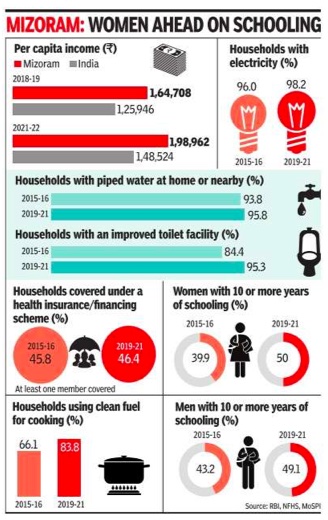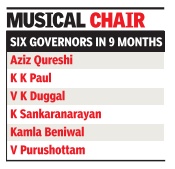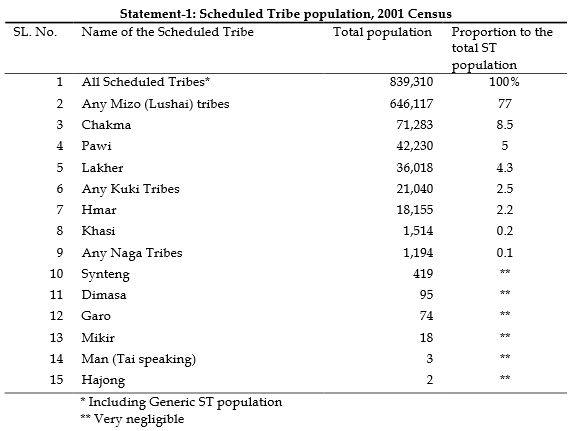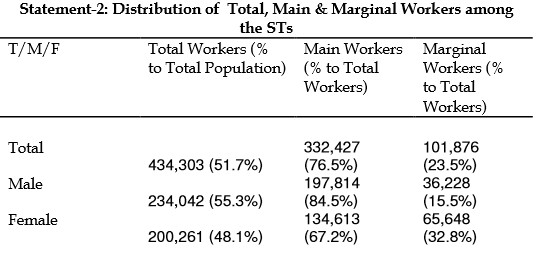Mizoram
Indpaedia has several pages on Mizoram, including Lushai Hills
This article has been sourced from an authoritative, official readers who wish to update or add further details can do so on a ‘Part II’ of this article. |
Contents |
The source of this article
INDIA 2012
A REFERENCE ANNUAL
Compiled by
RESEARCH, REFERENCE AND TRAINING DIVISION
PUBLICATIONS DIVISION
MINISTRY OF INFORMATION AND BROADCASTING
GOVERNMENT OF INDIA
Mizoram
Area : 21,081 sq km
Population : 10,91,014 (Prov. Census 2011) 8,91,058 (Census 2001)
Capital : Aizawl
Principal Languages : Mizo and English
HISTORY AND GEOGRAPHY
Mizoram is a mountainous region which became the 23rd State of the Indian Union in February 1987. It was one of the districts of Assam till 1972 when it became a Union Territory. After being annexed by the British in 1891, for the first few years, Lushai Hills in the north remained under Assam while the southern half remained under Bengal. Both these parts were amalgamated in 1898 into one district called Lushai Hills District under the Chief Commissioner of Assam. With the implementation of the North-Eastern Reorganisation Act in 1972, Mizoram bacame a Union Territory and as a sequel to the signing of the historic memorandum of settlement between the Government of India and the Mizo National Front in 1986, it was granted Statehood on 20th February 1987. Sandwiched between Myanmar in the east and the south and Bangladesh in the west, Mizoram occupies an area of great strategic importance in the north-eastern corner of India. Mizoram has great natural beauty and an endless variety of landscape. It is rich in fauna and flora.
The origin of the word ‘Mizo’ is not known. The Mizos came under the influence of the British Missionaries in the 19th century. Now most of the Mizos are Christians. Mizo language has no script of its own. The missionaries introduced the Roman script for the Mizo language and formal education. Literacy in the State has grown rapidly, and Mizoram's literacy at 91.58% is the third most literate in the country. Serchip District (98.76%) and Aizawl District (98.50%) recorded the highest literacy rates among districts in the country. The State also holds the highest child sex ratio with 971 females against 1000 males according to the 2011 Census.
AGRICULTURE
About 60 per cent of the people of Mizoram are engaged in agricultural and its allied activities. The main pattern of agriculture followed is Jhum or Shifting cultivation. Of the total 21% is put on the paddy/seasonal crops. About 63% of the total crop area is under Jhum cultivation. To replace the destructive and unproductive
Jhum cultivation with sustainable means of occupation, the State Government has launched an innovative programme called the New Land Use Policy cover all the districts of Mizoram. An integrated Land Use Planning, aimed at preservation of rain forests, creation of community reserve forests, supply reserves, earmarking of cultivation areas under New Land Use Policy, habitation and infrastructure developments will be adopted.
HORTICULTURE
6.30 lakhs hectare of land, out of the estimated total of 21 lakhs hectare, is available for cultivation of horticulture crops. The main horticulture crops are Mandarin Orange, Banana, Passion Fruit, Grapes, Hatkora, Pineapple, Papaya etc., and flowers like Anthurium, Bird of Paradise, Orchid, Chrysanthemum, Rose and other subsidiary seasonal flowers. Spices like Ginger, Turmetic, Black Pepper and Bird's eye Chillies are also grown. A Multi-purpose Packing House has been set up at the Horticulture Centre, Chite in collaboration with M/s Argos (Agri Projects) Ltd., Israel.
Floriculture is a growing occupation in Mizoram. Cultivation of anthurium had been introduced introduced in 2002 under the Technology Mission Programme. Today, Mizoram anthurium cut flowers are busing exported to other States of India and other countries like UAE and UK etc. Commercial cultivation of rose under hitech green house was introduced in 2006 by the Horticulture Department. Roughly 10,000 nos. of Rose cut flowers are being harvested everyday.
FORESTS
91.27% of the total geographical area (21,081 sq kms) is covered with forest which is the highest in the country. Out of this, 0.64% is very dense forest while a very substantial portion i.e. 69% is open forest. The hugely popular and effective Green Mizoram Programme has been continued to its refined form, giving more stress to the survival of the trees planted. 4700 hectares of plantation have been created under the National Afforestation Programme.
Recognizing the State's contribution in afforestation and wasteland development, the Ministry of Environment and Forests awarded the prestigious Indira Priyadarshini Vriksha Mitra (IPVM) Awards 2010 to Mizoram. the Aizawl Zoo has made premier record on the first ever successful captive breeding of the highly endangered and rare bird locally called Vavu or the Hame's Bartailed Pheasant.
IRRIGATION
Due to the hilly nature of the State, all irrigation projects are confined to Minor Irrigation. Wet Rice Cultivation potential area of Mizoram is estimated as 74,644 ha (as per Mizoram Remote Sensing Application Centre). 390 nos. of minor irrigation projects has been completed covering an area of 15,59 hectares. 49 nos. of minor irrigation projects covering an area of 2,639 ha are scheduled for completion during the year 2012-13.
INDUSTRY
Due to its topographical and geographical disadvantage coupled with underdeveloped infrastructure and transport bottleneck, growth in industry is very modes. However with the opening up of border trade with Myanmar and Bangladesh, the 'Look East Policy' of the Government of India and with the peaceful condition of the state, industralisation will substantially gain momentum in the near future.
Small industries dominate the industrial scenario acquiring prominent place in the socio-economic development of the state. The total number of small scale units registered upto 2009-10 was 7,888. With the objective of promoting industries in rural areas, the State Government is presently running two numbers of common facility centres and one RIDC with an intake capacity of 35 trainers. Infrastructural development like Industrial Growth Centre (IGC) at Luangmual, Aizawl, Export Promotion Industrial Park (EPIP) at Lengte, Integrated Infrastructural Development Centre (IIDC) at Pukpui, Lunglei and Food Park at Chhingchhip are nearing completion, apart from upgradation of the existing industrial estates.
Scientific cultivation of tea has also been taken up. Establishment of Apparel Training and Design Centre, Gems cutting and polishing are in the pipeline to encourage setting up of Export Oriented Units (EOUs). Of the cottage industries, Handloom and Handicrafts are given high priority and the two sectors are flourishing to meet consumers' demand in the state and in the neighbouring states of Meghalaya, Nagaland, etc.
POWER
The State's power demand is presently worked out to be 107 MW, the bulk of its power requirement is met from Central Sector Generating Stations in which the share of Mizoram is 65.31 MW. However, real time available power is normally 40 MW due to reduction of generation from Central Generating Station, Transmission Failure etc. The State's installed generation capacity as on January 2011 is 29.05 MW Hydel, 22.92 MW Bairabi Thermal Plant and 0.5 MW Diesel Generating Set, Lengpui.
Due to high generation cost, Bairabi Thermal Plant and DG Set at Lengpui are used only for emergency purposes. Total number of electric consumers as on 31st March 2010 is 153999 and number of electrified villages as on January 2011 is 603 out of 707 villages. Balance 104 villages are being electrified under RGGVY Scheme.
TRANSPORT
Road serves as the most important means of communication, transportation of goods and passengers within the state, inter state and with international borders. Total road length in the state is 6349.60 kms and road density is 300012km/100 sq km. approximately. There are 6 National Highways passing through the length and breadth of Mirozrm. NH-54 connects Aizawl with the rest of the country through Silchar. Aizawl is also accessible by road from Shillong and Guwahati.
Rail link in the state has been established at Bairabi, near the Assam border measuring 1.5 km from Katakal junction. The Airport at Lengpuri is connected by flights to and from Kolkatta, Imphal and Guwahati.
FESTIVALS
Mizos are basically agriculture oriented. All their activities centre around jhum cultivation and their festivals are linked with such agricultural operations. "Kut" is the Mizo term for festival. Among the various cultural festivals, only three, viz. Chapchar Kut, Mim Kut and Thalfavang Kut are observed today.
Music and dance is a vital part of Mizo society. Often called as, "Song bird of the East" the Mizos are blessed with a precious God given talent in music. Festivals are celebrated with vibratnt music, songs and beautiful energetic dances. Among the different folk dances, Cheraw, performed with bamboo is by far the most beautiful and well-known dance. In fact, Mizos set a new Gunnies World Record of the largest bamboo dance ensemble where 10,736 young men and women performed the Cheraw dance on 12th March, 2010.
TOURIST CENTRES
Aizawl, located at nearly 4,000 ft. above sea level, is a religious and cultural centre of Mizoram. Champhai is a beautiful resort on the Myanmar border. Tam Dil, a natural lake with virgin forests, is 80 km from Aizawl and 10 km from Tourist Resort of Saitual. Vantawng Falls, 5 km from the town of Thenzawl, is the highest and most beautiful waterfall in Mizoram. Phawngpuri is the highest peak of the state. The department of Tourism has opened Tourist Lodges in all the bigger towns all over the state, and Highway Restaurants and Travellers’ Inns in other townships. There is also a Recreational Centre at Beraw Tiling, Aizawl and Alpine Picnic Hut at District Park near Zobawk. Reiek Tlang, where the Tourism Department created a typical Mizo Village, modern Mizo village, resort and cafeteria is another tourist attraction where Anthurium Festival is held every year.
GOVERNMENT in 2012
Governor : Shri Vakkom B. Purushothaman
Chief Secretary : Shri Venhela Pachuau
Chief Minister : Shri Lal Thanhawla
Jurisdiction of High Court: Falls under the jurisdiction of Guwahati High Court. There is a bench at Mizoram.
AREA, POPULATION AND HEADQUARTERS OF DISTRICTS
S. No. District Area (sq km) Population Headquarters (Prov. Census 2011)
1. Aizawl 3,576.31 4,04,054 Aizawl
2. Lunglei 4,538.00 1,54,094 Lunglei
3. Chhimtuipui 1,399.90 56,366 Saiha
4. Lawngtlai 2,557.10 1,17,444 Lawngtlai
5. Champhai 3,185.85 1,25,370 Champhai
6. Kolasib 1,282.51 83,054 Kolasib
7. Mamit 3,025.75 85,757 Mamit
8. Serchhip 1,421.60 64,875 Serchhip
Developmental indicators
2015-21
See graphic:
Developmental indicators, Mizoram, 2015-21
Governors: 2014-15
Mar 29 2015
Qureshi 6th Mizoram guv sacked in 9 months
The Modi government on Saturday sacked Mizoram governor Aziz Qureshi, who had a running feud with the central government and had even approached the Supreme Court against attempts to remove him. With Qureshi's exit, the state has now seen six governors in the nine months since the NDA government took office. Mizo organizations, particularly students' groups, have accused the Centre of using the state as a “dumping ground“ of governors appointed by the previous UPA government. Qureshi, whose tenure was to expire in May 2017, is the second Mizoram governor to be sacked by the Modi government after Kamla Beniwal, who was removed soon after she was shifted from Gujarat Raj Bhavan to Mizoram.
“Qureshi shall cease to hold the office of the governor of Mizoram,“ said a note issued by Rashtrapati Bhavan.Bengal Governor Keshari Nath Tripathi, who already has additional charge as governor of Bihar, has been asked to discharge the functions of the Mizoram governor.
Qureshi, 74, had taken over as Mizoram governor on January 9 after being transferred from Uttarakhand.
The jinx with the Mizoram governor's office began in July last year when V Purushottam, who was transferred to the neighbouring state of Nagaland, quit saying that he had not been consulted over the move.
Mizoram: The Scheduled Tribes Census of India 2001
The population of Mizoram in 2001 Census has been 888,573. Of them, 839,310 are Scheduled Tribes (STs) constituting 94.5 per cent o f the total population of the state. The state has registered decadal growth of 28.4 per cent of ST population during 1991-2001. Thus, a predominant trib al state, Mizoram has fourteen communities notified as STs. All of them have been enumerated in 2001 Census. 2. Some of the significant demographic trends of the po pulation, revealed as per 2001 Census, are discussed in the foregoing paragraphs.
Population: Size & Distribution
3. Scheduled Tribe wise, Any Mizo (Lushai) tribes have th e major community constituting 77 per cent of the total ST pop ulation. Their decadal growth during 1991-2001 Census has been 29.2 per cent. Chakma is t he next largest ST in the state; they constitute 8.5 per cent of total ST population.
Pawi, Lakher, Any Kuki Tribes, and Hmar are the other tribe s having together a sizeable population constituting 14 per cent o f total ST population in the state. The rest of the STs have small population.
4. Mizoram is one of the few states having almost 50 per cen t of its population in the urban areas. The percentage of ST population in urb an areas is 48.7 per cent. 5. Majority of the population of Any Mizo (Lushai) tribe s, Hajong, Dimasa (Kachari), Garo, Synteng, Man (Tai speaking) are in ur ban areas. In contrast, Chakma population is primarily concentrated in r ural areas; merely 0.8 per cent of them reside in urban areas.
Sex Ratio
6. As per 2001 Census, the sex ratio of ST population as a who le is 984. Sex ratio among Any Mizo (Lushai) tribes is above the st ate average; so is the case in respect of Pawi. Low sex ratio has been registe red among Any Kuki Tribes (914), Chakma (929), and Any Naga tribes (941). 7. Child sex ratio in the age group 0-6 at 966 for all the ST s in the state is lower than 973 aggregated at the national level for STs. Am ong the major tribes, Mizo (Lushai) tribes (974) has higher child sex rat io, while Chakma (944) has recorded lower than the national average in 2001 Census.
Literacy & Educational Level
8. Mizoram is the leading state with the highest 89.3 per cen t literacy against 47.1 per cent recorded at the national level for ST population. The state holds the top rank for male (91.7%) and female (86.9%) literacy as well. 9. ST wise, Mizo (Lushai) tribes is on the top having 95.6 p er cent literacy. With male and female literacy at 96.8 per cent and 94.4 per cent r espectively, the gender gap in literacy is small. Chakma, Any Kuki tri bes, and Any Naga tribes exhibit higher male-female disparity in literacy.
Chakma has registered the lowest literacy of 45.3 per cent, with male and female l iteracy at 56.2 per cent and 33.6 per cent respectively.
10. As much as 27.9 per cent of the total ST population has bee n returned as students attending any of the educational institution s at 2001 Census.
Among Mizo (Lushai) tribes, this figure is 29.7 per cent, w hile Chakma has only 13.7 per cent population attending educational institu tions. Among the total population, majority i.e. 94.7 per cent are attending sc hool, 4.4 per cent college, 0.3 per cent vocational institute and 0.6 per cent o ther institute; the remaining 0.08 per cent are attending literacy centres. 11. Although, Mizoram is on top in total literacy, in the fi eld of higher education the scenario is not as impressive. Merely 3.9 p er cent of the literate population is having educational level graduate and above. M izo (Lushai) tribes is educationally better off, as they have the hig hest (4.3 %) population having this level.
Work Participation Rate (WPR)
12. 51.7 per cent of the population has been registered as wo rkers among the STs. This is significantly higher than the national average of 49.1 per cent recorded for ST population. 55.3 per cent males and 48.1 per ce nt females are workers, thus showing equitable participation of both m ales and females in workforce.
13. Three fourth of the tribal workers are main workers i n the state. 67.2 per cent ST females are main workers, which is signific antly higher than 53.3 per cent recorded at the national level for ST female workers.
Category of Workers
14. Among main workers, an overwhelming 60 per cent of the ST population is cultivators. The percentage of main worker s doing agricultural labour works is small at 3.1 per cent.
Marital Status
15. The distribution of ST population by marital status sh ows that 58.3 per cent of the population is never married, 36.2 per cent cur rently married, 3.2 per cent widowed, and the remaining 2.4 per cent divorced & separated.
16. In Mizoram, child marriage is not prevalent. Among STs, me rely 0.9 per cent female below 18 year of age, the legal age for fem ale marriage, has been recorded as ever married. Likewise, as per 2001 Census only 1.3 per cent males below the legal age of 21 year are ever married.
Religion
17. In Mizoram, majority of the ST population are Christian. In 2001 Census, 90.5 per cent of the ST population has been returned as Christian. The Buddhist at 8.3 per cent constitutes the second largest religious group of STs. Chakma are the main followers of Buddhism.



